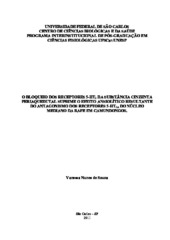| dc.contributor.author | Souza, Vanessa Nunes de | |
| dc.date.accessioned | 2016-06-02T19:22:07Z | |
| dc.date.available | 2012-05-31 | |
| dc.date.available | 2016-06-02T19:22:07Z | |
| dc.date.issued | 2011-12-15 | |
| dc.identifier.citation | SOUZA, Vanessa Nunes de. Blockade of 5-HT2 receptors in the periaqueductal grey matter (PAG) abolishes the anxiolytic-like effect of 5-HT1A receptor antagonism in the median raphé nucleus in mice. 2011.. 2011. 73 f. Tese (Doutorado em Ciências Biológicas) - Universidade Federal de São Carlos, São Carlos, 2011. | por |
| dc.identifier.uri | https://repositorio.ufscar.br/handle/ufscar/1236 | |
| dc.description.abstract | Several lines of evidence support the involvement of serotonergic (5-HT) neurons of the median raphe nucleus (MRN) in anxiety-like behaviour. In this context, it is known that blockade of 5- HT1A somatodendritic autoreceptors in the midbrain raphe nuclei increases the firing rate of these neurons, disinhibiting 5-HT release in postsynaptic target areas such as amygdala, hippocampus and periaqueductal grey matter (PAG). However, while activation of 5-HT1A or 5- HT2 receptors in forebrain targets such as the amygdala or hippocampus enhances anxiety-like behaviours in rodents, stimulation of both receptor subtypes in the midbrain PAG markedly reduces anxiety-like behaviour. In view of these findings, the present study investigated whether the anti-anxiety effects induced by pharmacological disinhibition of 5-HT neurons in the MRN are attenuated by the blockade of 5-HT2 receptors within the PAG. Mice received combined intra-PAG injection with ketanserin (10 nmol/0.1 μl), a 5-HT2 receptor antagonist, followed by intra-MRN injection of WAY-100635 (5.6 nmol/0.l μl), a highly selective 5-HT1A receptor antagonist. They were then individually exposed to the elevated plus-maze (EPM), with the videotaped behavioural sessions subsequently scored for both conventional and ethological measures. The results confirmed that intra-MRN infusion of WAY100635 (5.6 nmol/0.l μl)reduces behavioural indices of anxiety without significantly altering general activity measures, and further showed that this effect was completely blocked by intra-PAG pretreatment with an intrinsically-inactive dose of ketanserin (10 nmol/0.1 μl). Together, these results suggest that 5HT2 receptor populations located within the midbrain PAG play a significant role in the reduction of anxiety observed following disinhibition of 5-HT neurons in the MRN. | eng |
| dc.format | application/pdf | por |
| dc.language | por | por |
| dc.publisher | Universidade Federal de São Carlos | por |
| dc.rights | Acesso Aberto | por |
| dc.subject | Ansiedade | por |
| dc.subject | Labirinto em cruz elevado | por |
| dc.subject | 5-HT2 | por |
| dc.subject | Substância cinzenta periaquedutal | por |
| dc.subject | Camundongo | por |
| dc.title | Bloqueio dos receptores 5-HT2 da substância cinzenta periaquedutal suprime o efeito ansiolítico resultante do antagonismo dos receptores 5-HT1A do núcleo mediano da rafe em camundongos | por |
| dc.title.alternative | Blockade of 5-HT2 receptors in the periaqueductal grey matter (PAG) abolishes the anxiolytic-like effect of 5-HT1A receptor antagonism in the median raphé nucleus in mice. 2011 | eng |
| dc.type | Tese | por |
| dc.contributor.advisor1 | Souza, Azair Liane Matos do Canto de | |
| dc.contributor.advisor1Lattes | http://lattes.cnpq.br/2352004564367849 | por |
| dc.description.resumo | Várias evidências apontam o envolvimento de neurônios serotoninérgicos do núcleo mediano da rafe (NMnR) na ansiedade. Sabe-se que o bloqueio dos autorreceptores somatodendríticos dos núcleos da rafe aumenta a taxa de disparo dos neurônios serotoninérgicos, promovendo a liberação de serotonina em sítios pós-sinápticos como amígdala, hipocampo e substância cinzenta periaquedutal (SCP). Contudo, enquanto a ativação de receptores 5-HT1A ou 5-HT2 da amígdala ou hipocampo resulta em aumento da ansiedade em camundongos, a estimulação de ambos os receptores na substância cinzenta periaquedutal resulta em efeitos antiaversivos. Nessa perspectiva, o presente estudo investigou se o efeito ansiolítico induzido pela desinibição farmacológica dos neurônios serotoninérgicos do NMnR é suprimido pelo bloqueio dos receptores 5-HT2 da SCP. Para isso, camundongos receberam injeções combinadas de cetanserina na SCP (10 nmol/0,1μl), antagonista dos receptores 5-HT2B/2C, seguidas por injeções intra-NMnR de WAY100635 (5,6 nmol/0,1μl), antagonista seletivo dos receptores 5-HT1A. Os animais foram, então, individualmente expostos ao labirinto em cruz elevado (LCE) durante cinco minutos. Os testes foram gravados para posterior análise dos índices convencionais e etológicos de ansiedade. Os resultados confirmaram que infusões intra-NMnR de WAY100635 (5,6 nmol/0,1μl) reduzem os parâmetros comportamentais de ansiedade sem alterar índices de atividade locomotora, e que este efeito é completamente bloqueado pelo pré-tratamento com uma dose intrinsecamente inativa de cetanserina (10 nmol/0,1μl) na SCP. Dessa forma, estes resultados sugerem que os receptores 5-HT2 da SCP desempenham um papel significativo na redução da ansiedade observada após a desinibição dos neurônios serotoninérgicos do NMnR. | por |
| dc.publisher.country | BR | por |
| dc.publisher.initials | UFSCar | por |
| dc.publisher.program | Programa Interinstitucional de Pós-Graduação em Ciências Fisiológicas - PIPGCF | por |
| dc.subject.cnpq | CIENCIAS BIOLOGICAS::FISIOLOGIA | por |
| dc.contributor.authorlattes | http://lattes.cnpq.br/8438045901614166 | por |
